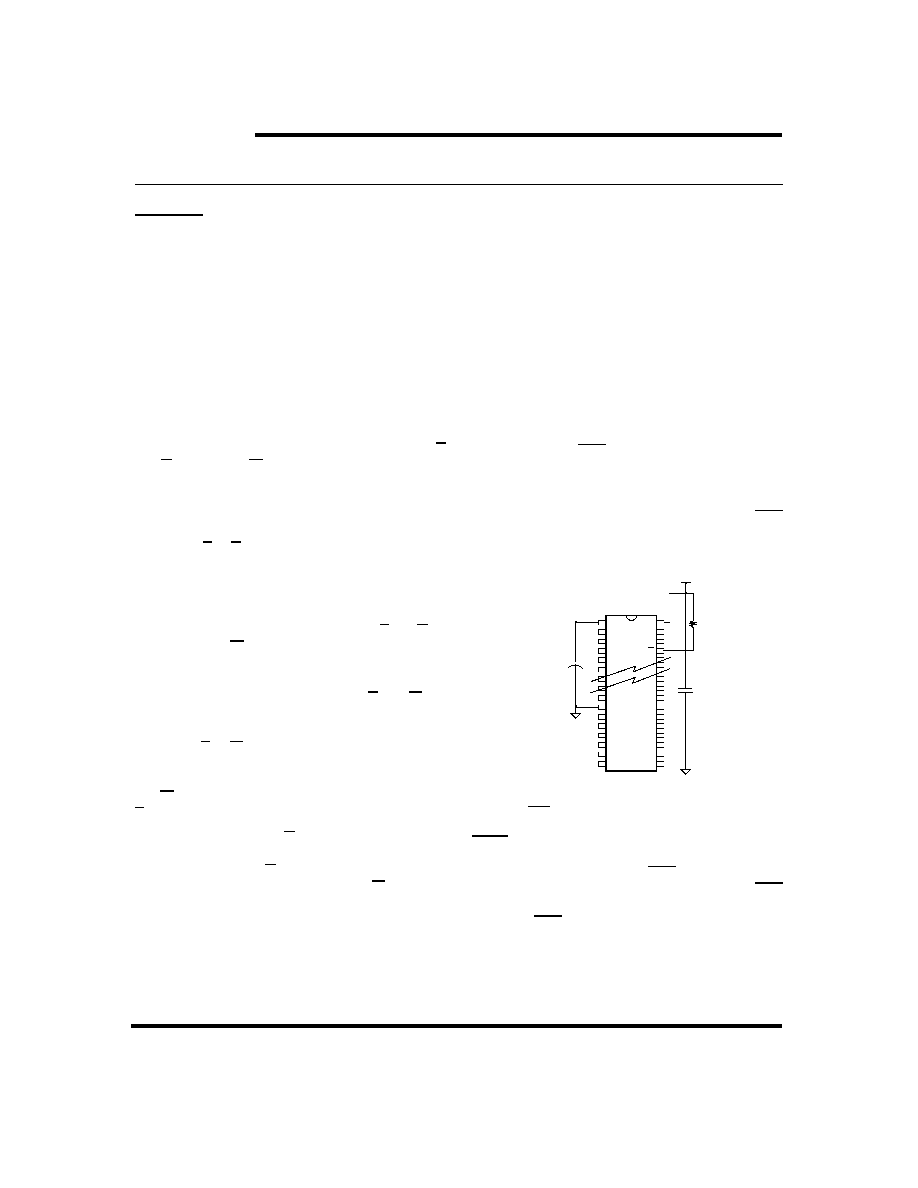- 您現(xiàn)在的位置:買賣IC網(wǎng) > PDF目錄98147 > STK17CA8-W45I REAL TIME CLOCK, PDIP40 PDF資料下載
參數(shù)資料
| 型號: | STK17CA8-W45I |
| 元件分類: | 時鐘/數(shù)據(jù)恢復(fù)及定時提取 |
| 英文描述: | REAL TIME CLOCK, PDIP40 |
| 封裝: | 0.600 INCH, DIP-40 |
| 文件頁數(shù): | 2/22頁 |
| 文件大小: | 579K |
| 代理商: | STK17CA8-W45I |

STK17CA8
June 2003
10
Document Control # ML0023 rev 0.2
nvSRAM
The STK17CA8 has two separate modes of opera-
tion: SRAM mode and nonvolatile mode. In SRAM
mode, the memory operates as a standard fast
static RAM. In nonvolatile mode, data is transferred
from SRAM to the nonvolatile elements (the STORE
operation) or from the nonvolatile elements to SRAM
(the RECALL operation). In this mode SRAM func-
tions are disabled. The STK17CA8 supports unlim-
ited reads and writes to the SRAM, unlimited recalls
from the nonvolatile elements and up to 1 million
stores to the nonvolatile elements
SRAM READ
The STK17CA8 performs a READ cycle whenever E
and G are low and W is high. The address specified
on pins A
0-16 determines which of the 131,072 data
bytes will be accessed. When the READ is initiated
by an address transition, the outputs will be valid
after a delay of t
AVQV (READ cycle #1). If the READ is
initiated by E or G, the outputs will be valid at t
ELQV or
at t
GLQV, whichever is later (READ cycle #2). The data
outputs will repeatedly respond to address changes
within the t
AVQV access time without the need for tran-
sitions on any control input pins, and will remain valid
until another address change or until E or G is
brought high, or W is brought low.
SRAM WRITE
A WRITE cycle is performed whenever E and W are
low. The address inputs must be stable prior to
entering the WRITE cycle and must remain stable
until either E or W goes high at the end of the cycle.
The data on the common I/O pins DQ
0-7 will be writ-
ten into the memory if it is valid t
DVWH before the end
of a W controlled WRITE or t
DVEH before the end of an
E controlled WRITE.
It is recommended that G be kept high during the
entire WRITE cycle to avoid data bus contention on
common I/O lines. If G is left low, internal circuitry
will turn off the output buffers t
WLQZ after W goes low.
AutoStore OPERATION
The STK17CA8 can be powered in one of three
modes.
During normal operation, the STK17CA8 will draw
current from V
CCX to charge a capacitor connected to
the V
CAP pin. This stored charge will be used by the
chip to perform a single STORE operation. After
power up, when the voltage on the V
CCX pin drops
below V
SWITCH, the part will automatically disconnect
the V
CAP pin from VCCX and initiate a STORE opera-
tion.
Figure 2 shows the proper connection of capacitors
for automatic store operation. A charge storage
capacitor having a capacity of between 10
F and
100
F (± 20%) rated at minimum of 5V should be
provided.
In order to prevent unneeded STORE operations,
automatic STOREs as well as those initiated by
externally driving HSB low, will be ignored unless at
least one WRITE operation has taken place since the
most recent STORE or RECALL cycle. Software initi-
ated STORE cycles are performed regardless of
whether a WRITE operation has taken place. HSB
can be used to signal the system that the
AutoStore cycle is in progress.
HSB OPERATION
The STK17CA8 provides the HSB pin for controlling
and acknowledging the STORE operations. The HSB
pin can be used to request a hardware STORE cycle.
When the HSB pin is driven low, the STK17CA8 will
conditionally initiate a STORE operation after t
DELAY;
an actual STORE cycle will only begin if a WRITE to
the SRAM took place since the last STORE or
Figure 2: AutoStore Mode
If HSB is not used it should be left uncon
nected
Vcap
Vss
Vccx
10
F
5v
,±20%
0.
1
F
By
pas
s
+
10
k
10k
W
DEVICE OPERATION
相關(guān)PDF資料 |
PDF描述 |
|---|---|
| STK17T88-RF45TR | PROGRAMMABLE TIMER, PDSO48 |
| STK17T88-RF45 | PROGRAMMABLE TIMER, PDSO48 |
| STK17T88-RF25ITR | PROGRAMMABLE TIMER, PDSO48 |
| STK17TA8-R25I | REAL TIME CLOCK, PDSO48 |
| STK17TA8-R35 | REAL TIME CLOCK, PDSO48 |
相關(guān)代理商/技術(shù)參數(shù) |
參數(shù)描述 |
|---|---|
| STK17T88-RF25 | 功能描述:NVRAM 32Kbx8+RTC 2.7-3.6V RoHS:否 制造商:Maxim Integrated 數(shù)據(jù)總線寬度:8 bit 存儲容量:1024 Kbit 組織:128 K x 8 接口類型:Parallel 訪問時間:70 ns 電源電壓-最大:5.5 V 電源電壓-最小:4.5 V 工作電流:85 mA 最大工作溫度:+ 70 C 最小工作溫度:0 C 封裝 / 箱體:EDIP 封裝:Tube |
| STK17T88-RF25I | 功能描述:NVRAM 32Kbx8+RTC 2.7-3.6V RoHS:否 制造商:Maxim Integrated 數(shù)據(jù)總線寬度:8 bit 存儲容量:1024 Kbit 組織:128 K x 8 接口類型:Parallel 訪問時間:70 ns 電源電壓-最大:5.5 V 電源電壓-最小:4.5 V 工作電流:85 mA 最大工作溫度:+ 70 C 最小工作溫度:0 C 封裝 / 箱體:EDIP 封裝:Tube |
| STK17T88-RF25ITR | 功能描述:NVRAM 32Kbx8+RTC 2.7-3.6V RoHS:否 制造商:Maxim Integrated 數(shù)據(jù)總線寬度:8 bit 存儲容量:1024 Kbit 組織:128 K x 8 接口類型:Parallel 訪問時間:70 ns 電源電壓-最大:5.5 V 電源電壓-最小:4.5 V 工作電流:85 mA 最大工作溫度:+ 70 C 最小工作溫度:0 C 封裝 / 箱體:EDIP 封裝:Tube |
| STK17T88-RF25TR | 功能描述:NVRAM 32Kbx8+RTC 2.7-3.6V RoHS:否 制造商:Maxim Integrated 數(shù)據(jù)總線寬度:8 bit 存儲容量:1024 Kbit 組織:128 K x 8 接口類型:Parallel 訪問時間:70 ns 電源電壓-最大:5.5 V 電源電壓-最小:4.5 V 工作電流:85 mA 最大工作溫度:+ 70 C 最小工作溫度:0 C 封裝 / 箱體:EDIP 封裝:Tube |
| STK17T88-RF45 | 功能描述:NVRAM 32Kbx8+RTC 2.7-3.6V RoHS:否 制造商:Maxim Integrated 數(shù)據(jù)總線寬度:8 bit 存儲容量:1024 Kbit 組織:128 K x 8 接口類型:Parallel 訪問時間:70 ns 電源電壓-最大:5.5 V 電源電壓-最小:4.5 V 工作電流:85 mA 最大工作溫度:+ 70 C 最小工作溫度:0 C 封裝 / 箱體:EDIP 封裝:Tube |
發(fā)布緊急采購,3分鐘左右您將得到回復(fù)。